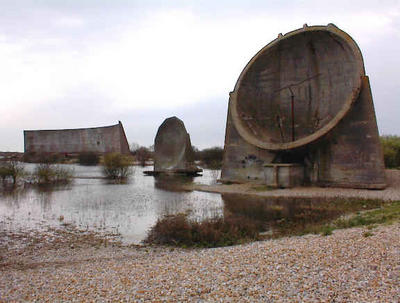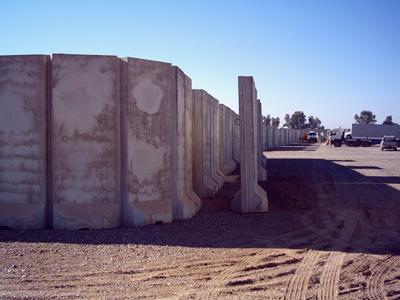It was like hiking through salad.
In any case, you don't often see people packing up the family car, or hopping onto a train, to tour Wales or the Green Mountains of Vermont so that they can listen to the hills – they'll go out to look at autumn leaf colors, sure, or take photographs of spring wildflowers. But to go all the way to Wales so they can hear a particular autumn wind storm howling through the gorges, a storm that only lasts two days of every year? Specifically going somewhere to *listen to the landscape*.
Seasonal weather events and their sonic after-effects. The Great November Moan.
All of which brings me to the idea of sound mirrors.

Musicalizing a weather system through landscape architecture.
BLDGBLOG here proposes a series of sound mirrors to be built in a landscape with regular, annual wind phenomena. A distant gully, moaning at 2am every second week in October due to northern winds from Canada, has its low, droning, cliff-created reverb carefully echoed back up a chain of sound mirrors to supply natural soundscapes for the sleeping residents of nearby towns.
Or a crevasse that actually makes no sound at all has a sound mirror built nearby, which then amplifies and redirects the ambient air movements, coaxing out a tone – but only for the first week of March. Annually.
Landscape as saxophone.

It's a question of interacting with the earth's atmosphere through human geotechnical constructions. Through sound mirrors.
What you'd need: 1) Detailed meteorological charts of a region's annual wind-flow patterns. 2) Sound mirrors. 3) A very large arts grant.
You could then musicalize the climate.
With exactly placed and arranged sound mirrors atop a mesa, for instance, deep inside a system of canyons – whether that's in the Peak District or Utah's Canyonlands National Park – or even in Rajasthan, or western Afghanistan – you could interact with the earth's atmosphere to create music for two weeks every year, amplifying the natural sounds of seasonal air patterns.
People would come, camp out, check into hotels, open all their windows – and just listen to the landscaped echoes.

A few questions arise: in this context, does Stonehenge make any sounds? What if – and this is just a question – it was built not as a prehistoric astronomical device but as a *landscape wind instrument*? You'd be out there wandering around the Cotswolds, thinking oh – christ, it's 5000 years ago and we're lost, but: what's that? I hear Stonehenge... And then you locate yourself.
Sonic landmark.
This raises the possibility of building smaller versions of these sound mirrors in urban neighborhoods so that, for instance, Berlin's Prenzlauer Berg sounds different than Mitte, which sounds different than Kreuzberg – which sounds different than South Kensington, which is different than Gramercy Park... Etc.
You'd always know which district of the city you were in – even which city you were in, full stop – based on what the wind sounded like.
(Which reminds me of another idea: that, to attract people to a city without much going for it, you could *flavor the water supply*: make it taste like Doritos, for instance, and then sell that on huge billboards: buy your new home in Detroit, the water tastes like Doritos... the water tastes like tofurky...).
Second: is there a sonic signature to the US occupation of Baghdad? And I don't mean rumbling Hummers and airplane engines, I mean what if all those Bremer walls –


– generate sounds during passing wind storms? All the American military bases of Iraq moaning at 3am as desert breezes pass by.
What does the occupation *sound like*?
A sonic taxonomy of architectural forms could begin...














































